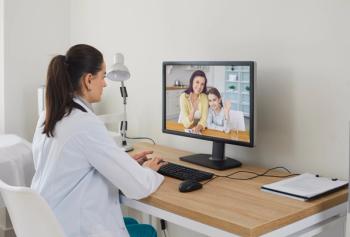
Telehealth: Beyond the pandemic
The pandemic catalyzed a huge uptick in telehealth services. Follow these best practices when using them.
In response to the COVID-19 pandemic, pediatric providers rapidly adopted telehealth virtual-visits to provide remote health care services for patients. The COVID-19 crisis established tele- health as an integral part of pediatric practice—one that can facilitate patient care, encourage patients to rejoin their medical home, and increase practice revenue at a time when pediatricians are recovering from pandemic-related revenue losses.
After reopening offices after the lockdown that occurred in the first few months of the pandemic, many pediatricians are performing fewer telehealth virtual visits than they did during this period. In my view, pediatricians should continue to innovate and increase utilization of telehealth communication with patients post pandemic.
Basics of telehealth visits
To satisfy Health Insurance Portability and Ac- countability requirements, a telehealth service encrypts video visit data to safeguard protected health information and protects data during transfer and storage. All telehealth service vendors must provide medical practices with a business associates agreement (BAA), detailing how the vendor is responsible for preventing and remedying data breaches. Once the pandemic is over, and emergency mandates either expire or are rescinded, practices will no longer be permitted to use programs such as FaceTime, Google Duo, Zoom (non–health care version) and others to provide virtual visits for patients. Additionally, post pandemic, practices may not be able to use phone calls as a substitute for “virtual visits.”
The quality of virtual visits is affected by band- width limitations (ie, high-speed vs low-speed internet vs cellular network connectivity), computer or smart device configuration issues, and a patient’s or a provider’s technical skill. Telehealth services vary in cost, and some are application based or browser based or both. Some telehealth companies sell a comprehensive “clinic” telehealth platform, that includes scheduling by office staff, a virtual waiting room, acceptance of payments, file sharing, and the ability to document visits within the telehealth portal or application itself. Not unexpectantly, telehealth services with more capabilities are more expensive and require a bit more training than basic telehealth applications.
I have selected several telehealth platforms (Table) among many dozens available, as premium products worth your consideration, and will briefly contrast and compare just a few of these - to help if you wish to consider an alternative telehealth service to the one you are now using.
One of the most popular telehealth applications is the Doximity Dialer included in the Doximity smartphone, tablet or desktop application.1 There are 2 versions, a free version that allows only one-on-one calls up to 40 minutes in length, and a pro version ($19.99 per month, per user) with unlimited minutes that supports group virtual visits. With either version, a provider sends a text message via the application on a smartphone, tablet, or computer to a patient’s mobile phone and launches the visit by clicking a button in the application. The patient clicks on a link embedded in the message and joins the visit. Users provide a caller ID to display on the recipient’s phone, so patients/parents see your office number rather than your own smartphone phone number. The video visit quality is excellent, and it is easy to communicate with the patient on your phone while reviewing the electronic health record (EHR) on your computer screen. The desktop application allows you to share your screen with a patient, and all versions have a “nudge” feature that lets you call a patient as you begin the telehealth session, to instruct them to click on a text link to begin. Best of all the application requires very few “clicks” to initiate a visit.
Another telehealth application to consider is Zoom for Healthcare.2 Zoom is application based and can be used on smart devices as well as computers. Zoom is extremely easy to use, and users merely initiate a visit by sending a link via email or messaging. Zoom for Healthcare provides a BAA to users, integrates a virtual waiting room, and one can record virtual visits for review at a later time. Zoom for Healthcare costs $14.99 per user for up to 9 users, with discounts available for prepayment. If you have a small office, this is a reasonable price, and you can assign your nursing and front office staff as users so they can communicate with patients via video, making patient communication more effective.
Pediatricians should be aware that there is a telehealth service dedicated to the unique needs of the pediatric practice. Anytime Pediatrics was developed over the course of several years by Mick Connors, MD, a pediatric emergency department (ED) physician.3 It’s been rapidly adopted by pediatric practices during the pandemic. The system enables pediatric practices to schedule telehealth visits with patients, and staff can “virtually” room a patient, confirm medications, update problem lists, and con- firm demographics, before the actual encounter with the physician. The Anytime Pediatrics application has an interface that is easy on the eyes, and easy to navigate. The system is quite affordable at $65 per clinician per month plus a setup fee for their Anytime Go Virtual Care service and by quote for their Anytime Premier Virtual Care Service. There is no charge for secretaries and other staff to use the program. I was very impressed with Anytime Pediatrics’ capabilities, and suggest you contact them for a demonstration.
Telehealth nuances: Tips and pitfalls
I’ve been doing telehealth visits for more than 7 years and along the way have made some observations worth sharing.
- First, virtual visits are often challenging when using a cellular network. Bandwidth affects communication and picture quality, and I would generally limit virtual visits to patients who have broadband internet, except in emergencies.
- Although comprehensive telehealth services with “virtual waiting rooms” have certain advantages, patients get annoyed if they are kept waiting. A non–waiting room system is very easy to use and is dependent on the provider sending a link to the patient, when the physician is ready to start. I favor basic systems, like the Doximity Dialer above, when one needs to initiate an impromptu visit.
- Remember to remind patients of upcoming virtual visits via phone or your office’s “appointment confirmation” service. Text messaging reminders are more effective than phone call reminders.
- Whenever possible, staff should “virtually room” patients prior to a virtual visit. This assures that patients have no technical issues. Rooming staff should document a weight or any vitals that may have been taken at home, confirm medications and pharmacy of choice, and record the visit’s “chief complaint.”
- To maximize revenue, consider converting regular phone calls to virtual visits and utilize impromptu visits when appropriate.
- Telehealth visits are ideal for following up on ADHD, depression, and anxiety. They are also appropriate when a patient has a rash, eye discharge, or similar complaint that can be easily diagnosed over the phone.
- Telehealth visits are ideal for following up on in-office visits such as asthma, pneumonias, and gastroenteritis where an examination may not be required.
- The quality of telehealth visits depends on a clinician’s level of comfort with the process. This improves with practice and experience. You will be surprised at how easy it is to arrive at a diagnosis by history with or without a limited examination.
- Do not be reluctant to cancel a telehealth visit if the patient needs to be seen in the office or sent to an ED. Make it clear that you will not charge for the virtual visit if you feel it is inappropriate for the situation.
Conclusion
The COVID-19 pandemic introduced pediatric providers to the many advantages of telehealth virtual visits. Postpandemic pediatric practices would be advised to continue to use telehealth when appropriate to do so. Patients already have learned just how effective these virtual visits can be for receiving care from their primary care physicians, compared with using community walk-in clinics or EDs.
References
1. Doxmity Dialer: Plans and pricing. 2021. Accessed July 26, 2021.
2. Zoom for healthcare. 2021. Accessed July 26, 2021.
3. Anytime Pediatrics Virtual Care Partner. 2021. Accessed July 26, 2021.
4. Doxy.me Pricing plans. 2021. Accessed July 26,2021.
5. VSee Pricing plans. Published 2021. Accessed July 26, 2021.
Newsletter
Access practical, evidence-based guidance to support better care for our youngest patients. Join our email list for the latest clinical updates.








